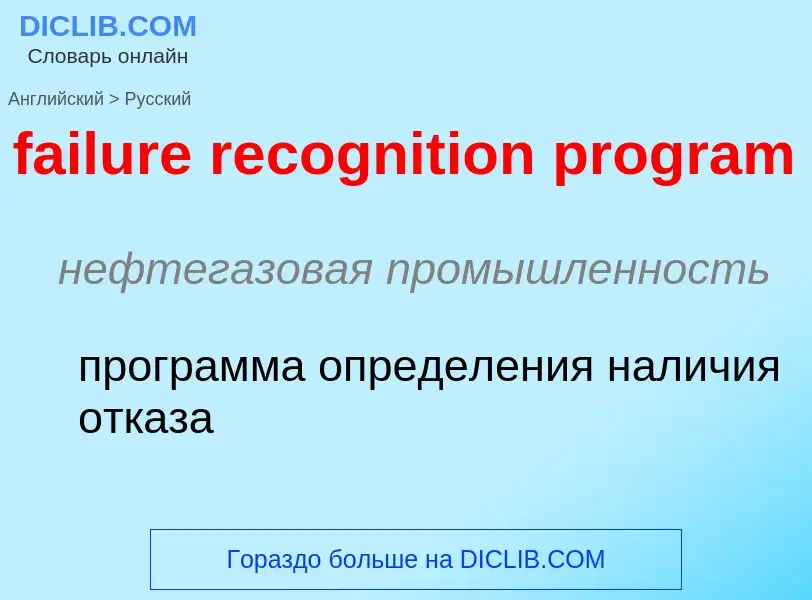Перевод и анализ слов искусственным интеллектом ChatGPT
На этой странице Вы можете получить подробный анализ слова или словосочетания, произведенный с помощью лучшей на сегодняшний день технологии искусственного интеллекта:
- как употребляется слово
- частота употребления
- используется оно чаще в устной или письменной речи
- варианты перевода слова
- примеры употребления (несколько фраз с переводом)
- этимология
failure recognition program - перевод на русский
нефтегазовая промышленность
программа определения наличия отказа
общая лексика
распознавание лиц
один из способов биометрической идентификации личности - способность компьютерной системы распознавать людей по изображению лица. Такая система должна различать личность независимо от цвета загара, изменения причёски и т.п.
Смотрите также
Определение
Википедия
The Orton-Gillingham approach is a multisensory phonics technique for remedial reading instruction developed in the early-20th century. It is practiced as a direct, explicit, cognitive, cumulative, and multi-sensory approach. While it is most commonly associated with teaching individuals with dyslexia, it is highly effective for all individuals learning to read, spell, and write. In the US, it is promoted by more than 15 commercial programs as well as several private schools for students with dyslexia and related learning disabilities.
The Academy of Orton-Gillingham, originally named “The Orton Society”, certifies individuals who have taken a training program with an OGA Fellow and who have completed a supervised practicum. This certifying committee is accredited under the NYS Board of regents.


![Disney's [[Magic Kingdom]], near [[Orlando, Florida]], during a trial of a facial recognition technology for park entry Disney's [[Magic Kingdom]], near [[Orlando, Florida]], during a trial of a facial recognition technology for park entry](https://commons.wikimedia.org/wiki/Special:FilePath/Disney Facial Recognition 20 April 2021.jpg?width=200)
![Boarding gates with facial recognition technology at [[Beijing West railway station]] Boarding gates with facial recognition technology at [[Beijing West railway station]]](https://commons.wikimedia.org/wiki/Special:FilePath/Entrance faregates at waiting room 10 of Beijing West Railway Station (20190908184801).jpg?width=200)
![Automatic face detection with [[OpenCV]] Automatic face detection with [[OpenCV]]](https://commons.wikimedia.org/wiki/Special:FilePath/Face detection.jpg?width=200)
![Flight boarding gate with "biometric face scanners" developed by [[U.S. Customs and Border Protection]] at [[Hartsfield–Jackson Atlanta International Airport]] Flight boarding gate with "biometric face scanners" developed by [[U.S. Customs and Border Protection]] at [[Hartsfield–Jackson Atlanta International Airport]]](https://commons.wikimedia.org/wiki/Special:FilePath/Facial recognition technology at gate (44275734970).jpg?width=200)
![The Viola–Jones algorithm for face detection uses [[Haar-like feature]]s to locate faces in an image. Here a Haar feature that looks similar to the bridge of the nose is applied onto the face. The Viola–Jones algorithm for face detection uses [[Haar-like feature]]s to locate faces in an image. Here a Haar feature that looks similar to the bridge of the nose is applied onto the face.](https://commons.wikimedia.org/wiki/Special:FilePath/Haar Feature that looks similar to the bridge of the nose is applied onto the face.jpg?width=200)
![pseudocolor]] image of two people taken in long-wavelength infrared (body-temperature thermal) light pseudocolor]] image of two people taken in long-wavelength infrared (body-temperature thermal) light](https://commons.wikimedia.org/wiki/Special:FilePath/Ir girl.png?width=200)
![In this [[shear mapping]] the red arrow changes direction, but the blue arrow does not and is used as eigenvector. In this [[shear mapping]] the red arrow changes direction, but the blue arrow does not and is used as eigenvector.](https://commons.wikimedia.org/wiki/Special:FilePath/Mona Lisa eigenvector grid.png?width=200)
![The face was automatically detected]] by special software. The face was automatically detected]] by special software.](https://commons.wikimedia.org/wiki/Special:FilePath/800px-Cool Kids of Death Off Festival p 146-face selected.jpg?width=200)
